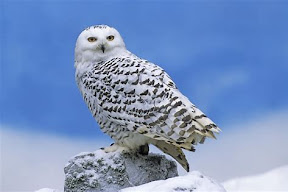Fast Facts: Snowy Owl

Presenting the Snowy Owl. AKA my childhood favorite owl. AKA the subject of my first science presentation. AKA HEDWIG The Snowy Owl : Bubo scandiacus Description : Being one of the most well-known owls on the planet, the Snowy Owl 's distinct white feathers patterned with black and brown make it stand out even in the snow-covered tundra. Males tend to have whiter overall while females have more pattering on their feathers. All Snowy Owls have especially thick feathers to protect them against the below freezing temperatures of the Arctic. With a wingspan of five feet and weight of 4 pounds, this adaptation also makes the Snowy Owl one of the largest and heaviest owls in the world. Habitat : Preferring habitats with elevation, such as outcrops and knolls, Snowy Owls are mostly found in open tundra and coastal habitats. In contrast, their habitats also often include flat and even areas where Snowy Owl parents will set up breeding sites for their young. In many cases, a tidal flat w


